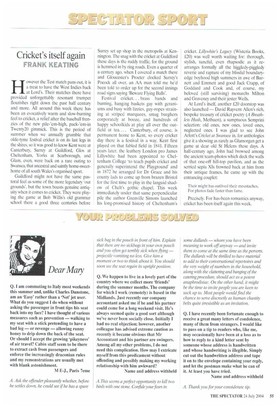Cricket's itself again
FRANK KEATING
However the Test match pans out, it is a treat to have the West Indies back at Lord's. Their matches there have provided unforgettably resonant trumpet flourishes right down the past half century and more. All around this week there has been an evocatively warm and slow-burning feel to cricket, a relief after the baseball frenzies of the new pile-'em-high, pack-'em-in Twenty20 gimmick. This is the period of summer when we annually grumble that olde-tme festival cricket is on its last legs in the shires, so it was good to know Kent were at Canterbury, Surrey at Guildford, Glos at Cheltenham, Yorks at Scarborough, and Glam, even, were back on a rare outing to Swansea, that ancestral and saintly home-sweethome of all south Wales's organised sport.
Guildford might not have the same pastoral feel as some of the more legendary out grounds', but the town boasts genuine antiquity when it comes to cricket. They were playing the game at Bob Willis's old grammar school there a good three centuries before Surrey set up shop in the metropolis at Kennington. The snag with the cricket at Guildford these days is the ruddy traffic, for the ground is hemmed in by ring roads. Even a quarter of a century ago. when I covered a match there and Gloucester's Procter clocked Surrey's Pocock all over, an AA man told me he'd been told to order up for the second innings road signs saying 'Beware Flying Balls'.
Festival cricket. . . brass bands and bunting, hanging baskets gay with geraniums and busy with lizzies, guy-ropes straining at striped marquees, smug burghers corporately at booze, and hundreds of happy schoolkids at play all over the outfield at tea.... Canterbury, of course, is permanent home to Kent, so every cricket day there is a festival in a way. Kent first played on that fabled field in 1841. Fifteen years later, the leathery London pro James Lillywhite had been appointed to Cheltenham College 'to teach pupils cricket and generally superintend the Playground' and in 1872 he arranged for Dr Grace and his county lads to come up from brazen Bristol for the first time to play in the languid shadow of Chelt's gothic chapel. This week immediately under that same perpendicular pile the author Grenville Simons launched his long-promised history of Cheltenham's cricket. Lillywhite's Legacy (Wisteria Books, £20) was well worth waiting for: thorough, stylish, tuneful, even rhapsodic as it rearranges formally all the higgledy-piggledy reverie and rapture of my blissful boundaryedge boyhood high summers in awe of Barnett and Emmett and good Jack Crapp, of Goddard and Cook and, of course, my beloved (still surviving) monarchs Milton and Graveney and their jester Wells.
At Lord's itself, another £20 doorstop was also launched — David Rayvern Allen's rich, bespoke treasury of cricket poetry (A Breathless Hush, Methuen), a sumptuous Semprini selection: old ones, new ones, loved ones, neglected ones. I was glad to see John Arlott's Cricket at Swansea in, for anthologies give it a showing as rarely as Glamorgan get a game at dear old St Helens these days. A half-century ago, John had browsed among the ancient team-photos which deck the walls of that one-off hill-top pavilion, and as the serried sepia Xis frowned back at him from their antique frames, he came up with the entrancing couplet:
Their might has outlived their moustaches, For photos fade faster than fame.
Precisely. For has-been romantics anyway, cricket has been itself again this week.


























































 Previous page
Previous page